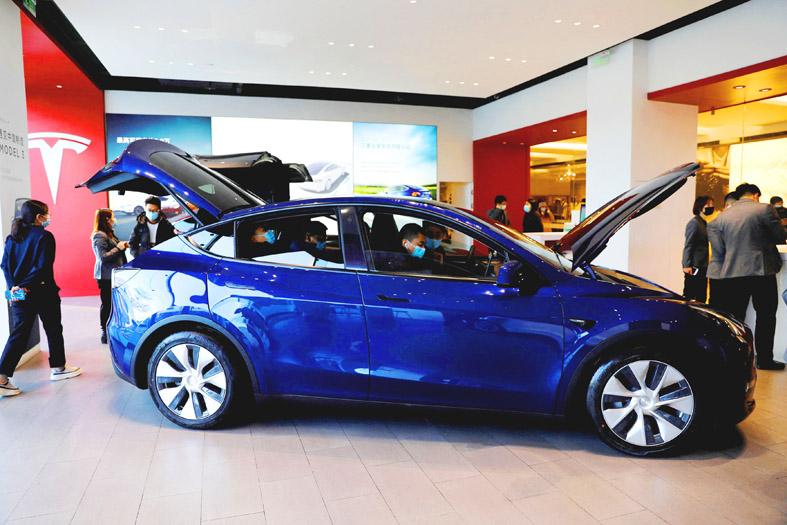Electric vehicles (EV) sales in China are forecast to hit a record 6 million this year as consumers flock to cleaner cars.
The China Passenger Car Association yesterday raised its estimate from 5.5 million, after releasing data showing deliveries of new-energy vehicles (NEVs) more than doubled last month to about 486,000 units — accounting for 26.7 percent of the new auto market.
Overall passenger vehicle sales increased 20.1 percent from a year earlier to 1.84 million units, the association said.

Photo: Reuters
The increased forecast represents a doubling from last year’s 2.99 million NEV sales, underscoring the dramatic growth in demand for cleaner cars in China, and the challenge for legacy automakers to adapt in a market that is rapidly going green.
The increased forecast of 6 million is still “relatively cautious,” the association said in a statement, adding that it could be further increased at the start of the fourth quarter.
Tesla Inc delivered 28,217 cars, with 8,461 going to the local market and 19,756 exported, mostly to Europe and Asia. The sharp drop of 64 percent from June was mainly caused by production shutdowns to upgrade its Shanghai factory as part of a plan to double annual capacity to 1 million vehicles.
BYD Co (比亞迪), which earlier this year ended production of cars powered only by fossil fuels, reported monthly sales of 162,530 units — both pure electric vehicles and plug-in hybrids.
While Tesla and BYD dominate EV sales, smaller start-ups are also making inroads as demand for clean cars surges.
Eight-year-old Hozon New Energy Automobile Co (合眾新能源汽車), which started by targeting customers outside big cities with budget cars, delivered 14,037 vehicles last month, including 1,382 to overseas markets.
Leapmotor Technologies Ltd (零跑科技), which competes in the same price range as Hozon, shipped a record 12,044 cars.
Overall, domestic automakers are grabbing a bigger slice of the NEV market. The main Chinese brands commanded 73 percent of NEV passenger car sales last month, up 9 percentage points from a year earlier.
Local upstarts, including the likes of Xpeng Inc (小鵬汽車), Li Auto Inc (理想汽車) and Nio Inc (蔚來汽車), accounted for 16.5 percent, while the main international joint ventures (which excludes Tesla) took just a 6.5 percent share.
The central and local governments have also taken steps to help the auto industry recover from COVID-19 lockdowns and restrictions that crushed sales earlier this year.
In May, the central government cut purchase taxes on some low-emission passenger vehicles by 50 percent, while municipal governments have pitched in with subsidies and incentives to entice buyers.

China has claimed a breakthrough in developing homegrown chipmaking equipment, an important step in overcoming US sanctions designed to thwart Beijing’s semiconductor goals. State-linked organizations are advised to use a new laser-based immersion lithography machine with a resolution of 65 nanometers or better, the Chinese Ministry of Industry and Information Technology (MIIT) said in an announcement this month. Although the note does not specify the supplier, the spec marks a significant step up from the previous most advanced indigenous equipment — developed by Shanghai Micro Electronics Equipment Group Co (SMEE, 上海微電子) — which stood at about 90 nanometers. MIIT’s claimed advances last

ISSUES: Gogoro has been struggling with ballooning losses and was recently embroiled in alleged subsidy fraud, using Chinese-made components instead of locally made parts Gogoro Inc (睿能創意), the nation’s biggest electric scooter maker, yesterday said that its chairman and CEO Horace Luke (陸學森) has resigned amid chronic losses and probes into the company’s alleged involvement in subsidy fraud. The board of directors nominated Reuntex Group (潤泰集團) general counsel Tamon Tseng (曾夢達) as the company’s new chairman, Gogoro said in a statement. Ruentex is Gogoro’s biggest stakeholder. Gogoro Taiwan general manager Henry Chiang (姜家煒) is to serve as acting CEO during the interim period, the statement said. Luke’s departure came as a bombshell yesterday. As a company founder, he has played a key role in pushing for the

Taiwan Semiconductor Manufacturing Co (TSMC, 台積電) has appointed Rose Castanares, executive vice president of TSMC Arizona, as president of the subsidiary, which is responsible for carrying out massive investments by the Taiwanese tech giant in the US state, the company said in a statement yesterday. Castanares will succeed Brian Harrison as president of the Arizona subsidiary on Oct. 1 after the incumbent president steps down from the position with a transfer to the Arizona CEO office to serve as an advisor to TSMC Arizona’s chairman, the statement said. According to TSMC, Harrison is scheduled to retire on Dec. 31. Castanares joined TSMC in

EUROPE ON HOLD: Among a flurry of announcements, Intel said it would postpone new factories in Germany and Poland, but remains committed to its US expansion Intel Corp chief executive officer Pat Gelsinger has landed Amazon.com Inc’s Amazon Web Services (AWS) as a customer for the company’s manufacturing business, potentially bringing work to new plants under construction in the US and boosting his efforts to turn around the embattled chipmaker. Intel and AWS are to coinvest in a custom semiconductor for artificial intelligence computing — what is known as a fabric chip — in a “multiyear, multibillion-dollar framework,” Intel said in a statement on Monday. The work would rely on Intel’s 18A process, an advanced chipmaking technology. Intel shares rose more than 8 percent in late trading after the